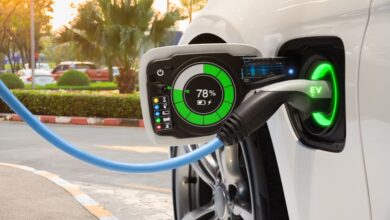World Environment Day: The Environmental Impact of Electric Vehicle Adoption Beyond Zero-Emissions – Blogs News

As the world continues to grapple with the challenges of environmental degradation, the widespread adoption of EVs offers a beacon of hope for a cleaner, healthier, and more sustainable future.
By Bharath Rao, Founder & CEO, Emobi
It’s no secret more countries are concerned about the threat of climate change. Some regions are already experiencing harsher weather conditions, such as severe droughts, flooding, storms, heat waves and rising sea levels. There’s a growing demand to reduce global carbon emissions and create a more sustainable transportation sector. For example, countries are focusing on transitioning to clean energy, which includes putting EVs on the road. Take California, for instance — it will officially ban the sale of all gas-powered vehicles by 2035.
The environmental impact of electric vehicle (EV
The positive environmental impact of EVs is multifaceted. Not only do they produce zero tailpipe emissions, but they are also more energy-efficient than traditional internal combustion engine vehicles. A National Bureau of Economic Research study found that EVs can reduce greenhouse gas emissions by up to 70% compared to their ICE counterparts. Moreover, EVs can help mitigate the effects of climate change by reducing the reliance on fossil fuels and promoting the adoption of renewable energy sources. As the world continues to grapple with the challenges of environmental degradation, the widespread adoption of EVs offers a beacon of hope for a cleaner, healthier, and more sustainable future.
- The Lifecycle of Electric Vehicles
An electric vehicle requires a lot of resources to develop from a concept to a reliable vehicle. There are serious environmental problems associated with the extraction of vital minerals like nickel, cobalt, and lithium, which are needed to produce batteries.
Manufacturing Process
An electric vehicle’s manufacturing process is an important part of its lifecycle. A significant quantity of electricity is needed for battery production, and depending on where that electricity comes from, that electricity may add to the indirect emissions of the car
Energy Source for Electricity
Operating an electric car has varying environmental benefits depending on where the electricity used for charging comes from. In areas where fossil fuels are the primary energy source for the grid, the indirect emissions from electric vehicles (EVs) reduce their advantage over conventional cars. On the other hand, EVs can fully reduce greenhouse gas emissions in regions where renewable energy sources are prevalent. This geographic variation emphasises how critical it is to switch to greener energy sources in addition to buying electric cars.
- End-of-Life Management
Battery Repurposing, Recycling and Disposal
The challenge of managing electric vehicle batteries as they age grows with the number of these vehicles on the road. Increasingly OEMs are looking to build vehicles with a second life use case in mind which would enable a second life use case in energy storage applications before finally being recycled.
Recycling Initiatives
Innovative recycling initiatives provide a glimpse into a future in which EV batteries’ environmental impact is significantly reduced. These programmes not only promote the circular economy
Comparative Environmental Benefits
When assessing the environmental impact of electric vehicles, it is critical to consider the bigger picture. Even with current lifecycle emissions, EVs have a lower environmental impact than internal combustion engine vehicles. This advantage is expected to grow as battery technology, renewable energy infrastructure, and recycling methods advance. For commercial users, switching to EVs represents an opportunity to significantly reduce operational emissions and contribute to a more sustainable future.
Conclusion
A key component of the global plan to fight climate change is the use of electric vehicles. Despite the environmental difficulties posed by their manufacture and use, it is evident that EVs provide a way to cut emissions and promote a cleaner environment. Electric vehicles have the potential to completely transform transportation in a sustainable way as long as technology develops and the industry changes. Investing in electric vehicles (EVs) is a proactive move that shows environmental stewardship and aligns businesses with forward-thinking practices that customers are becoming more and more interested in. Every advancement in electric vehicle technology increases the promise of a truly sustainable mobility future as long as we keep innovating and improving.
(Disclaimer: Views and opinions expressed by the author do not reflect the beliefs of Financial Express Digital)



